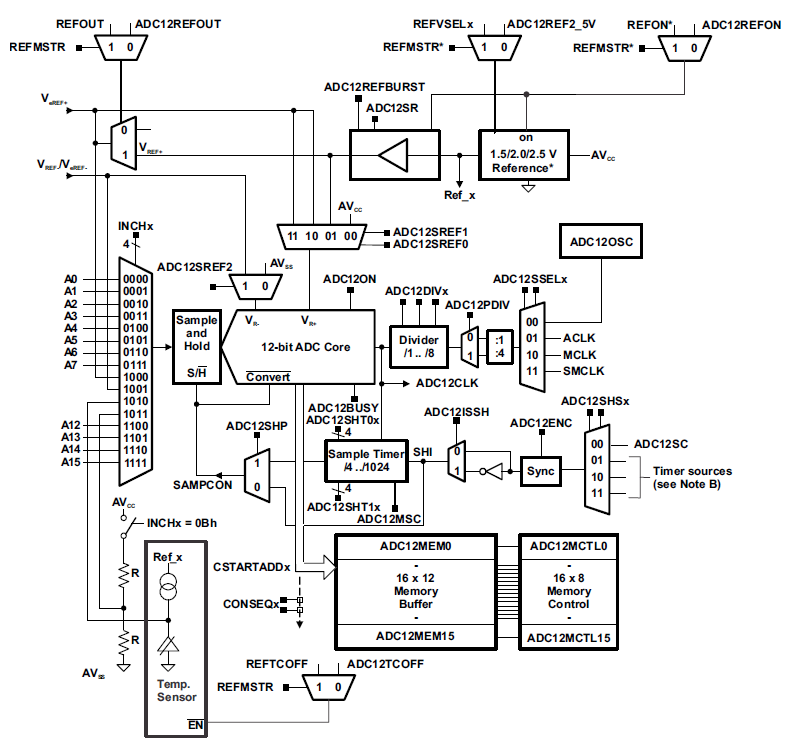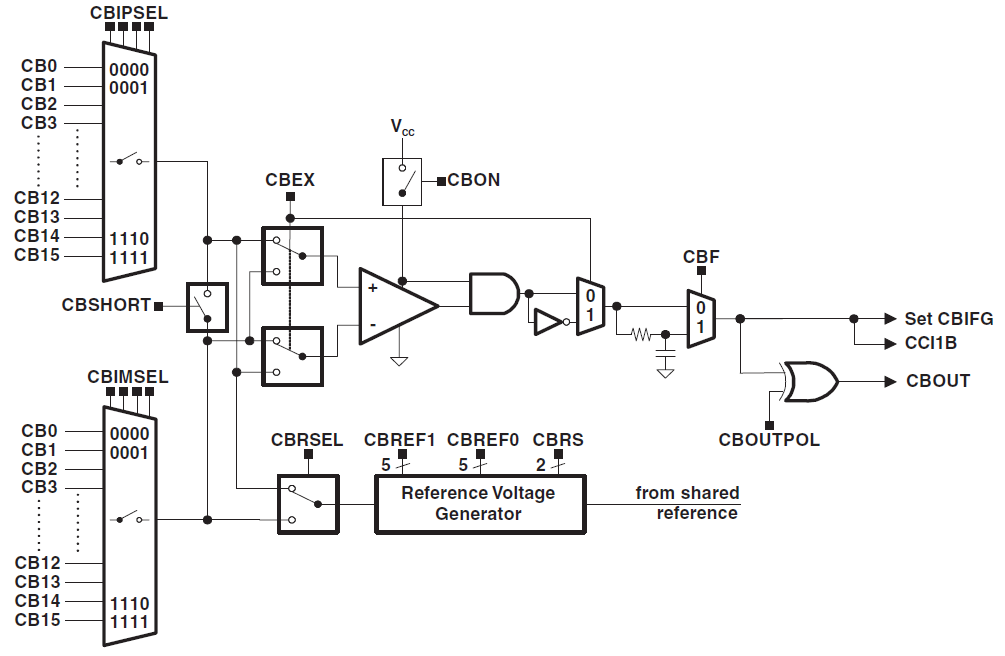Tinkering TI MSP430F5529

|
|
Analogue Hardware Overview
Except Digital-to-Analog Converter (DAC), MSP430F5529 microcontroller offers two major analogue hardware peripherals – ADC12_A and Comp_B+. Additionally, there is an on-chip reference voltage generator called REF module that can generate pretty accurate voltage references – 1.5V, 2.0V and 2.5V reference voltages.
As the name suggests ADC12_A is a fast 12-bit Analogue-to-Digital Converter (ADC). Since it has higher resolution compared to other typical 8-bit and 10-bit ADCs of other microcontrollers, it much more precise when it comes to reading analogue voltages. MSP430s usually pack SAR ADCs and the ADC12_A of MSP430F559 is a 200+ ksps Successive Approximation (SAR) ADC. ADC12_A has an internal temperature sensor and REF module’s reference voltages can be used with ADC12_A for more precise measurements. It is also possible to use external sources. Positive and negative references can be independently selected. Sample-and-hold circuitry offers programmable sampling periods via timers or software. In MSP430F5529, there are 16 individually configurable input channels – 12 external input channels and 4 internal input channels. There also 16 buffer registers to store AD conversion data. Since MSP430F5529 hosts a Direct-Memory-Access (DMA) peripheral, it can be combined with ADC12_A and we can get some more interesting effects.

A comparator compares two analogue voltage levels. This comparison results in an indication of which signal is at a higher/lower voltage level than the other. In simple terms, it is a one-bit ADC. Though it may look that a comparator is unnecessary when we have a good built-in ADC, it is otherwise. A comparator is a very important analogue building block. It is helpful in places where knowing voltage levels is more important the voltage itself. This makes it faster than an ADC in such cases. Owing to this a whole lot of electronics is based on it. Examples of such electronics include oscillators, level sensing, VU meters, capacitive touch sensing, measurement devices, etc. A LC meter is a perfect example. A LC meter is usually based on an oscillator. This oscillator uses a comparator. Its frequency varies with the L and C components, oscillating at a fixed frequency with known L and C values. Measuring frequency shifts as a result of changing L/C values leads us to measure unknown L/C effectively.

|
|
Hello, what software are you using for the Hardware setup images and does it support simulation for the MSP430F5529
I used Proteus VSM for drawing schematics but it doesn’t support simulation.
Hi,
Im interfacing MSP430F5529 with MAX17055 fuel guage. while reading 16 bit value, the first byte im receiving is 0. so while reading multiple registers continuously the data exchange is happening, but im getting the correct data. Can anyone suggest me what will be the issue? why im getting 0 in first byte?
read16_bit data code:
uint16_t value = 0;
USCI_B_I2C_setslaveaddress(USCI_B1_BASE, slave_address);
USCI_B_I2C_setmode(USCI_B1_BASE, USCI_B_I2C_TRANSMIT_MODE);
USCI_B_I2C_masterSendStart(USCI_B1_BASE);
while (!USCI_B_I2C_masterSendStart(USCI_B1_BASE));
USCI_B_I2C_mastterSendSingleByte(USCI_B1_BASE, reg_address);
USCI_B_I2C_setslaveaddress(USCI_B1_BASE, slave_address);
USCI_B_I2C_setmode(USCI_B1_BASE, USCI_B_I2C_TRANSMIT_MODE);
USCI_B_I2C_masterReceiveMultiByteStart(USCI_B1_BASE);
uint8_t lb = USCI_B_I2C_masterReceiveMultiByteNext(USCI_B1_BASE);
uint8_t hb = USCI_B_I2C_masterReceiveMultiByteFinish(USCI_B1_BASE);
while (USCI_B_I2C_isBusBusy(USCI_B_BASE));
value = lb << 8;
value |= hb;
return value;
In code, after sending reg address, it will be recieve mode. its a type mistake
Hi, im trying to send the command from the terminal view. i can able to send the command and tried to blink p1.0 led in msp430f5529 controller, its working fine. And im using led driver IS31FL3236A interfaced with msp430f5529 controller, i can able to interface im getting the expected output.
now i need to send the command from seriak monitor based on that command i2c communication need to start. both communication are working fine, when it runs separately. its not working when i tried to combine.
any one had any idea, why it is happening or what will be the issue?
It could be due to:
1. conflicts in clock settings
2. hardware conflict like pin mapping
3. code is getting stuck or waiting for one communication line to finish
4. use of polling method instead of interrupt-driven coding
Hi, thank you for the respose.
Do I need to use different clock initialization for I2C and UART communication? if YES, can you explain how to do that?
I mean check which clock has been set for UART and I2C…. Is it SMCLK, MCLK, etc and is it tuned to right frequency required by the respective hardware?
Is there any example on how to implement polling method in uart?
Why go for polling method when it is a blocking method of coding? It is better to use interrupts instead at least for UART receive.
yes!! currently in my code, only for uart im using interrupts to recieve command from serial monitor. Im not using interrupt for I2C communication.
so the issue is must be in clock initialization. right?
For UART, im using USCI_A1_BASE. and for I2C, im using USCI_B1_BASE.
And another thing i need to ask is, in uart when i tried blink led(p1.0) in msp430f5529 by passing command. here, without clock I’m getting output. how it is possible?
And for both i2c and uart i gave SMCLK with 1Mhz
I am surprised and happy to find this tutorial on the F5529 as TI makes a lot of different devices.
Thank you very much for putting in the extra knowledge in each segment, made reading worthwhile.
Good Work!
lovely tutorial but to be honest I don’t think I’d be investing my time on this board to start with it’s not cheap and readily available as the stm32 boards can you please do more tutorials on stm32 board’s and the stc micros thanks
Hello, I try to program MSP430FR6047 but i get error “the debug interface to the device has been secured”. when flashing using uniflash and when program using CCS this happen. can you help me to solve this problem
You can try “On connect, erase user code and unlock the device” option.
Pingback: Tinkering TI MSP430F5529 – gStore
Hello
I am doing project of msp430g2553 interface(using i2c communication) with temp 100(temperature sensor) and try to read the temperature in dispaly(16*2) but didn’t get the out put (using code composer studio) can u share me any example code for this project
Thank you sir,
Which sensor? Did you use pullup resistors for SDA-SCL pins?
Where is lcd_print.h?
All files and docs are here:
https://libstock.mikroe.com/projects/view/3233/tinkering-ti-msp430f5529
You want the truth? TI makes and sell “underpowered micros”, you know? Low everything, not only the power but also peripherals. So the price is not justified.
Otherwise, if I’ll move there, I’ll introduce them to my small hobby projects – there are still some advantages.
I may even make a visual configuration tool of my own for them…
Yeah the prices of TI products are higher than other manufacturers but I don’t think the hardware peripherals are inferior.
Not inferior but in not enough numbers compared to STM32.
True